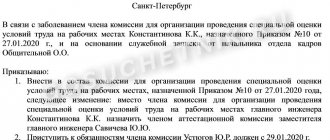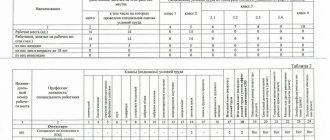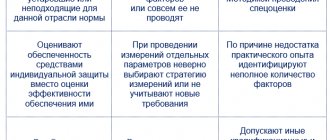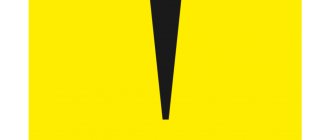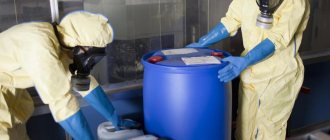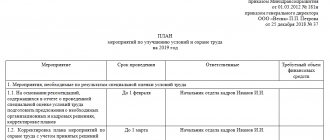What is a special assessment of working conditions
This is a set of measures, the purpose of which is to establish the presence of harmful factors in each workplace and assign it a risk class.
This is stated in Article 1 of the Federal Law of December 28, 2013 No. 426-FZ “On Special Assessment of Working Conditions” (hereinafter referred to as the Law on SOUT). There are four risk classes:
- Optimal (1.0): dangerous and (or) harmful production factors are either completely absent or are at a level that is safe for humans. The prerequisites have been created to maintain a high level of performance.
- Acceptable (2.0): there are dangerous and (or) harmful factors, but their impact does not exceed the levels established by hygiene standards. The altered functional state of the body is restored during rest, at the beginning of the next working day or shift.
- Harmful (3.0): levels of exposure to negative factors exceed the standard. It is divided into subclasses: first degree (3.1), second degree (3.2), third degree (3.3) and fourth degree (3.4).
- Dangerous (4.0): levels of exposure to negative production factors can create a threat to the life of an employee, and the consequences can lead to the development of an occupational disease.
The results of the SOUT are used, among other things, when assigning discounts and surcharges to the rate of contributions “for injuries” and additional tariffs for pension contributions. Employees who work in workplaces classified as hazardous (subclasses 3.2, 3.3 and 3.4) or hazardous classes are granted additional leave (Article 117 of the Labor Code of the Russian Federation). For classes 3.0 and 4.0, a salary increase of at least 4% of the salary or rate is provided (Article 147 of the Labor Code of the Russian Federation). There are other benefits as well.
Calculate “complex” salaries with coefficients and bonuses for a large number of employees
Who may not conduct an assessment of working conditions
SOUT is not mandatory for the following categories:
- organizations and individual entrepreneurs who have not concluded a single employment contract;
- employers - individuals without individual entrepreneur status;
- employers - religious organizations.
All employers, without exception, have the right to refuse SOUT in relation to the workplaces of homeworkers and remote workers (Part 3 of Art. Law on SOUT).
ATTENTION. Vacant positions are not subject to special assessment. The fact is that in the absence of employees, it is impossible to analyze their working conditions.
What is a special assessment
A special assessment of working conditions is an event whose purpose is to determine the degree of influence of harmful factors on the employer’s employees. Depending on whether hazardous factors are detected or not and the extent of their impact on personnel, the employer makes a number of decisions, including:
- on providing additional guarantees to employees;
- on providing employees with personal protective equipment;
- on modernization of the production process to reduce harmfulness.
The mandatory nature of the special assessment and the algorithm for carrying out special assessments are enshrined in Federal Law No. 426-FZ dated December 28, 2013.
IMPORTANT!
Assessment of working conditions is mandatory for all employers, except for employers - individuals and religious organizations. Workplaces of homeworkers and remote workers are not subject to inspection.
Neglect of labor assessment threatens the employer with liability under Art. 5.27.1 Code of Administrative Offenses of the Russian Federation. The assessment procedure is fixed by law.
Read more: What are dangerous and harmful production factors
Brief step-by-step instructions for carrying out SOUT consists of the following elements, the implementation of each of which is mandatory:
Who conducts a special assessment of working conditions
SOUT is carried out by a specialized third-party company with the participation of a commission created by the employer.
The commission includes: representatives of the employer and trade union organization (if it is created at the enterprise), an occupational safety specialist (see “How to become an occupational safety specialist”). It also needs to include the head of a small enterprise or individual entrepreneur. The head of the commission is appointed by the employer himself or his representative.
Compose HR documents using ready-made templates for free
The specialized third party company must meet the following criteria:
- SOUT is its main activity.
- The appropriate accreditation has been obtained.
- The staff includes at least 5 experts who have a certificate to perform special assessment work. At least one expert is a doctor in general hygiene (or occupational hygiene) or a doctor in sanitary-hygienic laboratory research.
- There is a testing laboratory accredited to measure harmful and dangerous factors in the production environment and the labor process.
What is a special assessment of working conditions (SOUT)
Special assessment of working conditions (hereinafter referred to as SOUT) is the identification of harmful and dangerous factors of production, measurement of the level of their impact on the employee, and the organization of safe workplaces.
A special assessment of working conditions (law) is a single set of consistently implemented measures to identify harmful and (or) dangerous factors in the working environment and the labor process and assess the level of their impact on the employee, taking into account the deviation of their actual values from those established by the federal executive body authorized by the Government of the Russian Federation authorities of standards (hygienic standards) of working conditions and the use of personal and collective protective equipment for workers (Article 3 of Federal Law No. 426).
Who should conduct a special assessment of workplaces (SOUT)
The procedure is mandatory for all employers with the exception of individuals who are employers but do not have individual entrepreneur status. The working conditions of homeworkers and those who work remotely are not subject to mandatory special assessment. In addition, individual entrepreneurs who do not have workers do not carry out SOUT “for themselves,” but the directors of organizations that do not have hired workers are required to evaluate their workplace.
Why is a special assessment of working conditions carried out? It is necessary to assess the safety of the workplace and is aimed at eliminating identified harmful factors, or providing benefits and guarantees in connection with the “harmfulness” of these workplaces.
Procedure for carrying out SOUT
Before starting the procedure, it is necessary to draw up a work schedule and a list of jobs that are subject to a special assessment. The form of these documents is free.
REFERENCE. SOUT is carried out in relation to the workplace, not the position. Therefore, if one person combines several positions at once, then you need to check how many jobs he actually occupies. And include each one in the list.
Further research is carried out within the framework of SOUT. Based on their results, a report is compiled. It is signed by specialists from an accredited third-party organization and members of the commission. At the same time, a card is filled out for each workplace (report forms and cards approved by order of the Ministry of Labor dated January 24, 2014 No. 33n). Employees should be familiarized with the card against signature within 30 calendar days from the date of approval of the report. Within the same period, summary data of the special assessment must be published on the employer’s official website (if available).
In addition, a declaration of compliance with working conditions is drawn up (the form and procedure for submission approved by order of the Ministry of Labor dated 02/07/14 No. 80n). It includes information about workplaces where harmful and dangerous production factors have not been identified, and working conditions are recognized as optimal and acceptable. The declaration must be submitted to the territorial labor inspectorate no later than 30 working days after approval of the report based on the results of the special labor inspection. The declaration can be submitted online on the Rostrud website. To do this, it must be signed with a qualified electronic signature.
Receive an enhanced qualified electronic signature certificate in an hour
How to save on special assessments
If no harmful and (or) dangerous factors are identified at the workplace after a special assessment, the employer submits a declaration of compliance with working conditions to the labor inspectorate. Deadline - no later than 30 working days from the date of approval of the report on the special assessment of working conditions (Part 1, Article 11 of Law No. 426-FZ).
Information on the results of a special assessment in relation to workplaces, the working conditions of which are declared as complying with state regulatory requirements, is transferred by the appraiser company to the FSIS SOUT (Part 1, Article 18 of Law No. 426-FZ).
The employer has the right to reduce the number of special assessments carried out in relation to such jobs if the following conditions are met:
Fulfillment of these conditions allows you to automatically extend the validity period of the declaration and shift the date of the next assessment of the workplace for working conditions by another five years. In this case, no additional documents are required (letter of the Ministry of Labor dated August 30, 2019 No. 15-1/OOG -1968).
Find out where you can legally save money, and when it’s dangerous to do so:
- “What are the possibilities for optimizing taxes under the simplified tax system”;
- “Business fragmentation: where is legitimate optimization, and where is tax evasion?”;
- “Investment tax deduction - a new opportunity to optimize income tax”.
Timing and frequency of carrying out SOUT
The last stage of the special assessment was completed by January 1, 2019 (Part 6 of Art. Law on SOUT). It is assumed that by this date all employers have carried out the above activities and submitted the declaration on time.
When should the next SOUT procedure be scheduled? If there are no industrial accidents or occupational diseases, and inspectors do not find violations in the field of labor protection, there is no need to do a second special assessment. And only upon the occurrence of one of these events, it is necessary to carry out an unscheduled assessment of labor conditions and re-submit the declaration (see “The declaration of special assessment of working conditions was made indefinite”).
IMPORTANT. When a new workplace appears, it is necessary to organize an unscheduled special assessment. This must be done within 12 months from the date it was put into operation.
SOUT when renaming a position
However, Art. 17 426-FZ provides for a number of cases when changes affecting a certain job position are considered minor. These cases include:
- changing the personal data of the employer, which is an individual entrepreneur. Personal data means his last name, first name and patronymic;
- reorganization of the company and changes in organizational working conditions for this position, which did not affect the nature of the technological process;
- changing the job title without introducing innovations into the composition of production technology at a given place of work.
The final decision on whether the changes made are significant or insignificant is made by a special commission organized by the employer. If the company has a trade union organization, it is advisable to coordinate such a decision with its representatives. The corresponding decision should be recorded in writing in the form of a local legal document. The current legislation does not provide a special model for such a decision. Therefore, the commission has the right to formalize it in any form. Care should be taken to ensure that it is signed by the chairman of the organization and all its members, and that the date is indicated on it. The document must clearly state that there is no need to conduct a special assessment at a given workplace or several places.
Terms of SOUTH at new workplaces
The procedure for organizing SOUT for new employees is described in Art. 17 of Federal Law 426-FZ. It establishes that, in accordance with Part 2 of this article of this regulatory document, the terms of the SOUT for a new workplace should be no more than 12 months. Conducting a special assessment in this case is regarded as unscheduled. Therefore, even if the organization has a valid document confirming the implementation of special assessment and assessment at all other places of work, performing a special assessment in this case is mandatory.
We clarify that if the organized workplace is not yet occupied, then conducting an SOUT does not make any sense. When an employee is found to fill a vacant position, the employer negotiates with him about guarantees and compensation, which are determined by the results of the special assessment and assessment process. After a special assessment, you need to add a class of working conditions to the contract and, if necessary, all compensation and guarantees that the employee is entitled to by law.
The cost of the special assessment and who pays for it
The law does not regulate the cost of the procedure. The price depends on a number of factors: market conditions, size of the organization, number of staff, etc. On average, SOUT for one place costs from 600 rubles. Most accredited companies have set a lower price threshold: even if a special assessment needs to be carried out for a small number of jobs, for example, one or two, you will have to pay at least 10,000 rubles for the procedure.
As a general rule, the employer must finance the entire range of measures for a special assessment of working conditions. But he can reimburse a certain amount through contributions for insurance against industrial accidents and occupational diseases. It is permissible to direct part of such contributions to the prevention of injuries and occupational diseases, including to the SOUT (see “The procedure for reimbursement of expenses for the reduction of injuries and occupational diseases has been changed”).
